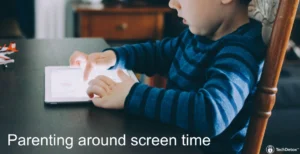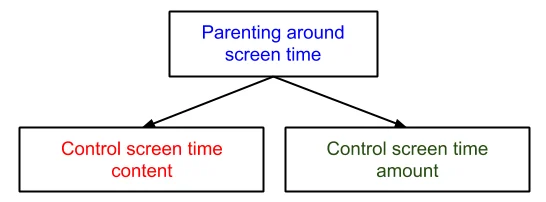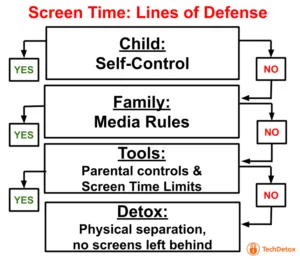
8 Parenting Strategies To Limit Screen Time
What is our goal?
What is the definition of success in the art of screen time management?
No one knows exactly, it’s not in the textbooks – yet. But we can speculate that the final product should include some of the following:
- Time spent in reality exceeds time spent on screens. Their brain is formed in the real world, and their neurological development is not compromised in unknown ways.
- Healthy social skills. They have real-world offline friendships and can comfortably talk face-to-face with people of all ages and backgrounds. They have empathy for others.
- Self-image based on intrinsic value. Kids are resilient to comparisons driven by social media. Their mental health does not depend on “likes”.
- Ability to focus. Kids can concentrate on one project at a time and see it to completion. They are not distracted. They succeed academically.
- Love of reading and learning.
- Peace of mind. They are not overwhelmed by too much digital media. They are not anxious, and they sleep well.
- Physical fitness. They spend time moving their body, screens do not compromise their physical health.
- Critical thinking skills. They can form their own opinions instead of blindly accepting what is popular or trending.
All of these great outcomes are compromised by digital media overuse.
What do teens actually want when it comes to parents’ control over their digital lives? Complete hands off. They think they know better and can make their own judgments about digital content they consume. For an average of 9 hours a day. As a parent, I don’t think so. Not on my watch.
Reading teens’ comments on Common Sense Media about what they think of parents monitoring their phones is so educational. A teen, 16 years old, writes: “If you had taught your child right, your job is to trust their judgement!” Wow, this is a clever move: if you check on me, you are a bad parent!
Don’t take the bait.
Teens’ reactions can basically be summarized into the following categories:
- “They don’t trust me, but I know I am mature and trustworthy!”
- “They violate my privacy – who gave them the right?! I don’t snoop around on their phones!”
- “They take away my freedom to explore the world through my phone as I see fit!”
Fair enough. Let’s look at the arguments one by one.
- Teens are not mature adults, because their brains are not fully developed – in particular, the prefrontal cortex, where maturity and self-control actually resides. Science tells us that the prefrontal cortex is not fully grown until age 25 or so. Sorry, teens, you don’t have the hardware for the software of responsible digital media use you claim to have. Parents know that teens are prone to make mistakes (they remember being teens themselves), and they want to protect you – because they love you.
- Parents not only have the right – according to the law, they have the obligation to care for and control their children under age 18 and authority to make decisions regarding their wellbeing. So if a parent suspects that whatever teen is doing privately on their phone is not good for their welfare, they have the right to check – and to take the phone away if necessary.
- Teens’ natural curiosity can take them to dark places online, where they risk experiencing things that can permanently damage their minds, and even cause physical harm. Violence, porn, predators, disorders, depression, anxiety, and suicide are all residents of the digital world.
The primary reason most parents buy the phone for their child is to be able to always get in touch with them and to know where the kids are.
In other words, to keep the kids safe.
What the parents need is the phone with calls, texts, and a GPS tracker! But a smart phone comes preloaded with addictive video games, time-sucking social media, and a whole list of potential dangers that exposure to the open Internet brings, from manipulative marketing to pornography and online predators.
Since children are not prepared for the dangers of the digital world, parents have to serve as an external shield of protection.
This concept is not new – psychologists call it being an “ancillary brain” for your child. An adult acts as an extra brain to perform cognitive functions a child’s brain is not yet fully capable of.
The idea is to give their brain the time to catch up and get in the game.
Throughout recent history parents took action to protect their kids from the dangers of drugs, alcohol, unprotected sex, drunk driving, bad peer influence and the like. Since the dawn of the digital age a new item has been added to the list of harms – digital addiction. And it might be the hardest to control, because it is so ubiquitous – it is the new normal. It is the business model of a multi-billion dollar industry, it is at home, at school, in everyone’s hands – it’s everywhere. But while kids are under our roof, it’s within our power to prevent overuse, if we want our children to have a good outcome in life.
More and more research comes out to demonstrate that a smartphone is about the most dangerous thing we hand to our kids. We won’t give our underage youngsters a loaded gun or car keys, yet we give them access to the world of addictive gaming, toxic social media, shocking violence, online porn and predators – as early as elementary school.
Research shows that digital media overuse leads to all kinds of negative consequences for our children: from compromised academic performance to the destruction of social skills, from sleep deprivation to anxiety and depression and teen suicide. When you start learning about the consequences of uncontrolled technology use, it’s scary.
Let’s explore what parenting strategies can help us in the digital battle.
Strategy #0: Delay
It’s an open secret that screen time is a BIG problem. Make your life easier. If you have a chance, spare yourself the trouble and delay the onset of screen time management until your child is older. Wait Until 8th campaign encourages parents to delay giving kids a smartphone until at least 8th grade and backs up this recommendation with research.
Also, as much as it is in your power, minimize the number of devices your child uses – and you need to monitor. It’s a lot of work, really.
Once technology enters your children’s lives, you have to deal with it, no matter how busy you are.
Strategy #1: Communication
Wiser parents insist that technology use is not a right, but a privilege. This privilege is conditional on certain factors that may vary between families but usually include a combination of things like:
- Responsible behavior online (staying off inappropriate content, being respectful in online communications, staying safe, etc.)
- Reasonable time limits for digital media use
- Maintaining good grades
- Completing chores
- Having healthy offline interests and relationships
Have an ongoing dialog with your children about responsible digital media use:
- Explain the dangers
- Set expectations and establish family media rules
- Discuss consequences for rule violations in advance
Strategy #2: Monitoring
Screen time monitoring comes down to two parallel processes:

Much of our site is devoted to exploring various solutions that help parents do exactly that.
Strategy #3: Substitution
A simple life hack to the screen time management problem is to have your child spend more time in the real world. If they are too busy with school and activities, there is naturally less time left for screens.
See some ideas of screen time substitutes here.
Dragging kids to sports practice away from the screens 5 times a week does not seem so bad when we look at the idea of shaping your child’s environment for a better outcome in life. After all, if they are not at the practice or a game, what would they be doing? Enjoying quality time with their XBox, shooting monsters.
Strategy #4: Environment
Our biggest impact as parents may be in shaping our kids’ environment to help them thrive.
In the book The Nurture Assumption: Why Children Turn Out the Way They Do by psychologist Judith Rich Harris, the central idea is that our modern culture makes a mistake assigning too much value to the role of parents (nurture) vs genetics (nature), which might actually play a much bigger role in kids’ outcomes in life. If the kid made it to the Ivy League school, the parent should not take too much credit. On the other hand, if they totally messed up their life, it’s not mom’s fault either!
What the author argues is that the environment is not the same as nurture.
Building a healthy “habitat” for our kids might be our best chance as parents to positively influence them. For example, peers have an outsized influence on teens. Well, parents have a role in selecting their children’s peer group – simply by moving a family to a town with an excellent school system. Our lectures about the value of education might bounce off, but if we place our kids in an environment of positive peer influence, their friends will drive home the value of academic excellence much better than we do.
Same logic is true for shaping the home environment. Overscheduling (Strategy #3) works great outside the home. What about the time kids are at home and not scheduled for any extracurricular activities?
Remove screens and place books in front of them.
The only unlimited screen time in our house is on reading kindles. If you have only healthy food choices around the house, your children will eat healthier, their only option once they get hungry! And if we limit their steady diet of digital media “junk food”, their academic performance, social skills, physical and mental health are likely to improve as well. Agreeing on family media habits and placing some protective boundaries with parental controls are the tools to build a healthy digital environment at home.
Strategy #5: Consequences
No Tolerance For Tech Tantrums
Building a screen-free habitat is easier said than done! As great as it would be if our kids came up with their own solutions to fill their screen-free time with wholesome free play or reading, that does not always happen. Chances are they are going to fill the screen vacuum with whining, fighting, begging, negotiating, and a thousand other ways to make parents’ lives miserable in hopes that you will buckle and reunite them with the screens to get back your peace.
I have witnessed this behavior in my own home daily, and in my friends’ homes many times. It’s the pinnacle of parental embarrassment, because the kids would consciously sabotage your time with your friends with an ugly “tech tantrum” so you give them the devices to keep them quiet.
As they get older, they would perform this ritual quite consciously and deliberately. They torment us because they know: the more difficult they become, the more likely we are to surrender. The kids are laser-focused on a single goal: exhaust the reserves of parental willpower and win the screens back.
Don’t reward this behavior with screen time unless you want to see it repeated. If parents are attacked with a “tech tantrum”, screen time is cancelled for the day.
Digital Grounding: Take The Phone Away
And then there are inevitable violations of digital rules parents established. Your teen has done something incredibly dangerous or stupid online, and parents have to resort to some tough love.
About two thirds of parents confiscate teens’ phones as a form of punishment, according to a study by Pew Research Center.
The World Health Organization posted this parenting advice during the COVID-19 lockdown:
“Taking away a teenager’s phone for a week is hard to enforce. Taking it away for an hour is more realistic”. So there you have it – taking the phone away from a child for more than an hour is “cruel and unusual punishment” according to the leading health authority in the world. Teens can get by just fine without food and water for hours, but not without the phone. I respectfully disagree.
Parents have always used grounding as a form of effective discipline. But what has emerged in the recent years can be called digital grounding – if a teen’s phone is taken away, they are essentially cut off from their social world for a while, which is a more effective consequence than confining them to their rooms in the pre-smartphone age.
Three Types of Parenting
In our Western culture of respect for individual rights and freedoms some parents decide that they need to treat children the same way. They may find the idea of taking devices away to restrict kids’ God-given right to use them offensive. Like a violation of human rights. Except, this attitude leads to what is called permissive parenting. Permissive parenting is defined as a parenting style with very few rules, when a parent is more like a friend, not an authority.
Experts warn us against this style of parenting. While being nurturing and loving is good for the kids, imposing no limits and boundaries to what they are allowed to do is not. The opposite of permissive parenting is another extreme. An authoritarian parenting style, when a parent is a drill sergeant making all the decisions and tolerating no opposition, has a different set of negative implications for the child – from inability to think for themselves to parent-child relationship damage.
The best parenting style is called authoritative parenting, when parents encourage mature, responsible behavior by enforcing healthy boundaries, within which children have enough freedom to make their own decisions and develop critical thinking skills. Authoritative parents impose natural consequences when kids break pre-agreed upon rules – and when it comes to digital media use, the consequence for breaking family screen time policies is the temporary loss of technology privileges, in other words, digital grounding.
Strategy #6: Rewards
This one is a simple principle: business before pleasure. Yes, you can have your screen time as soon as the homework is done, the room is clean, vegetables are eaten, books are read, your body got some exercise, and chores are completed. Extra screen time can be given for additional chores of the parent’s choosing.
Strategy #7: Lead by example
Are you the adult you want your child to be?
Frances E. Jensen in her book The Teenage Brain: A Neuroscientist’s Survival Guide to Raising Adolescents and Young Adults writes that you cannot preach abstinence from smoking if you are a smoker. By the same logic, you cannot preach abstinence from phones if you are always on yours.
It’s hard to keep screen time management for kids and adults as two separate topics. Because when it comes to parenting, “do as I say, not as I do” rarely works. Kids would notice your double standards – and question your credibility.
Kids are learning by example. Teens are powerfully wired to imitate the behavior of the group to fit in. If all of their friends are on Snapchat, or on TikTok, that’s what they want to do too. And if normal teen behavior is using screens for 7-9 hours a day, your child will want to imitate that new normal too. They are unlikely to see counterexamples among other teens.
It’s up to the parent to be the example of healthy screen-time habits – and most parents fall short here.
Children adopt the habits of their parents, consciously or subconsciously. If they see you read books, they will read. If they see you on your phone, what right do you have to expect them to behave differently? Whatever is the norm for the family, they will perceive it as acceptable human behavior and adopt for themselves.
Why Do We Parent
Parenting a child is about giving them enough freedom within safe boundaries to make their own choices and mistakes, fail and learn from their failures. The boundaries we establish should protect them from truly disastrous, catastrophic mistakes with long-term or life threatening consequences: like drugs, drunk (or distracted) driving, teen pregnancies and STDs, and yes – the behavioral addiction to digital media.
Our kids might resist our parenting efforts today, but hopefully, when they grow up, they will understand. The quote from the beginning of the 20th century, often attributed to Mark Twain, goes as follows: “When I was a boy of 14, my father was so ignorant I could hardly stand to have the old man around. But when I got to be 21, I was astonished at how much the man had learned in seven years.”
Keep up the good work.








If there’s one unifying message across most of the research behind screen time and kids, it’s that parents shouldn’t feel guilty about allowing their children to use digital media. Screens aren’t going away anytime soon, so we need to find a way for kids to engage with them in a positive way and find a place for them in home environments. Above all, each home, family and child is different, so find a relationship with screens that works best for